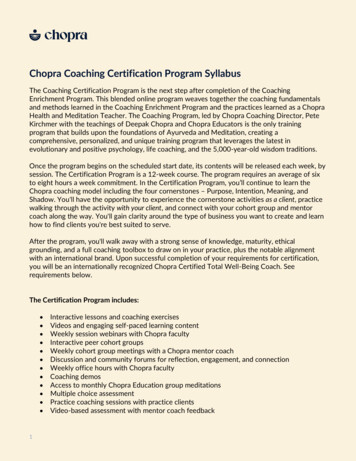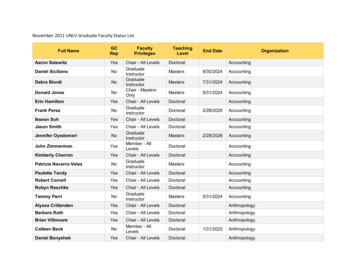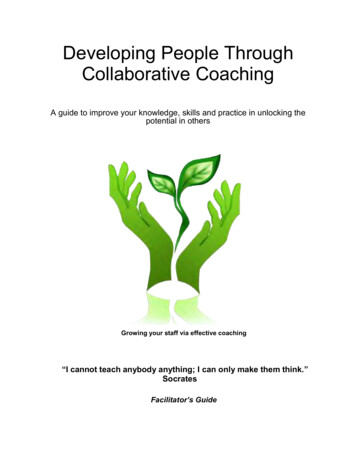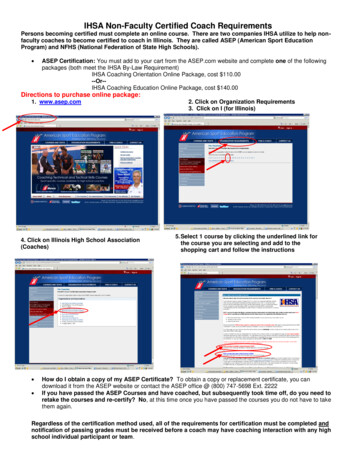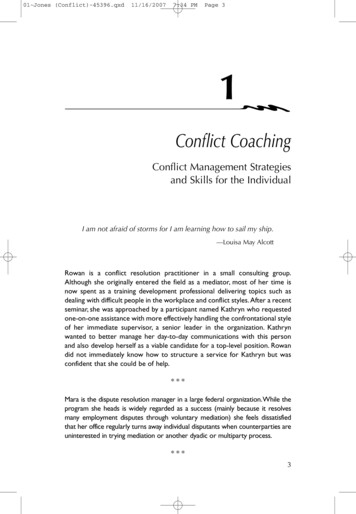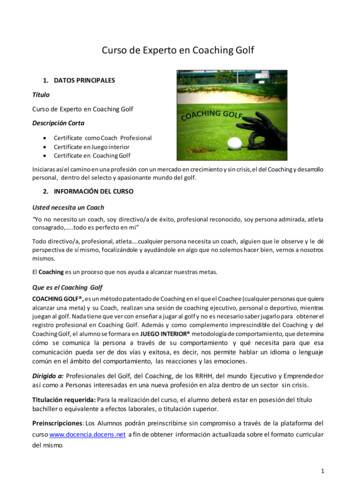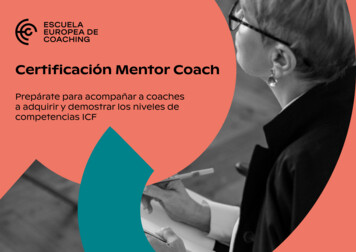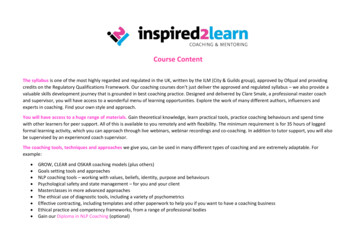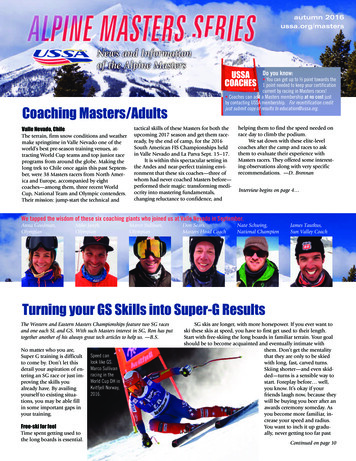
Transcription
autumn 2016ussa.org/mastersCoaching Masters/AdultsValle Nevado, ChileThe terrain, firm snow conditions and weathermake springtime in Valle Nevado one of theworld’s best pre-season training venues, attracting World Cup teams and top junior raceprograms from around the globe. Making thelong trek to Chile once again this past September, were 38 Masters racers from North America and Europe, accompanied by eightcoaches—among them, three recent WorldCup, National Team and Olympic contenders.Their mission: jump-start the technical andUSSACOACHESDo you know: You can get up to ½ point towards the1 point needed to keep your certificationcurrent by racing in Masters races! Coaches can add a Masters membership at no cost justby contacting USSA membership. For recertification creditjust submit copy of results to education@ussa.org.tactical skills of these Masters for both theupcoming 2017 season and get them raceready, by the end of camp, for the 2016South American FIS Championships heldin Valle Nevado and La Parva Sept. 15–17.It is within this spectacular setting inthe Andes and near-perfect training environment that these six coaches—three ofwhom had never coached Masters before—performed their magic: transforming mediocrity into mastering fundamentals,changing reluctance to confidence, andhelping them to find the speed needed onrace day to climb the podium.We sat down with these elite-levelcoaches after the camp and races to askthem to evaluate their experience withMasters racers. They offered some interesting observations along with very specificrecommendations. —D. BrennanInterview begins on page 4 We tapped the wisdom of these six coaching giants who joined us at Valle Nevado in September.Anna Goodman,OlympianMike Janyk,OlympianMarco Sullivan,OlympianDon Sears,Masters Head CoachNate Schwing,National ChampionJames Tautkus,Sun Valley CoachTurning your GS Skills into Super-G ResultsThe Western and Eastern Masters Championships feature two SG racesand one each SL and GS. With such Masters interest in SG, Ron has puttogether another of his always great tech articles to help us. —B.S.No matter who you are,Super G training is difficultto come by. Don’t let thisderail your aspiration of entering an SG race or just improving the skills youalready have. By availingyourself to existing situations, you may be able fillin some important gaps inyour training.Free-ski for feelTime spent getting used tothe long boards is essential.Speed canlook like GS.Marco Sullivanracing in theWorld Cup DH inKvitfjell Norway,2016.SG skis are longer, with more horsepower. If you ever want toski these skis at speed, you have to first get used to their length.Start with free-skiing the long boards in familiar terrain. Your goalshould be to become acquainted and eventually intimate withthem. Don’t get the mentalitythat they are only to be skiedwith long, fast, carved turns.Skiing shorter—and even skidded—turns is a sensible way tostart. Foreplay before well,you know. It’s okay if yourfriends laugh now, because theywill be buying you beer after anawards ceremony someday. Asyou become more familiar, increase your speed and radius.You want to inch it up gradually, never getting too far pastContinued on page 10
News & Info of the Alpine MastersNational Chairperson’s Reportby Lisa Densmore Ballard, Chair,USSA National Masters CommitteeIt’s been a busy 1 ½ years since I took overas Chair of USSA’s Masters committee, notonly for me, but also the division chairswho are most active in Masters ski racing.Next time you ride up a chairlift with BillMcCollom (Eastern), Nadine Price (NewEngland), Ryan Fuller (Central), Fran Noel(Northern), Gary Randall (Alaska), RobCravens (PNSA), Dan Simmons (Far West),Lauren Beckos (Rocky), Stu Marsh (Intermountain), as well as Meri Stratton, Esther DellaQuadri and DebLewis, please say thank you. These volunteers not only play a criticalrole in coordinating the ski races you attend, but also lend theirbrainpower and time to help me move masters ski racing ahead nationally. And we have made strides!With the help of Deb Lewis, the 2016–17 Masters Handbookis again updated to keep pace with our ever-changing sport. Wait‘til you see what Lauren Beckos has done to improve the Mastersposter, too! It’s not only an attractive way to publicize Mastersevents in all USSA divisions in one place, but now it will hopefullyget more people to them. Recruitment continues to be one of thebig goals for your national Masters committee. We’re hoping towelcome those from NASTAR, who want more variety and challenge, to Masters racing and have a number of cross-promotionswith them underway for this winter. We’re also looking at ways toraise awareness about the Masters circuit among all levels of collegeracers. And new this winter, spearheaded by Rob Cravens, I’ll behosting a women’s-only ski racing clinic with PNSA to hopefullyrecruit a few moms of junior racers into the Masters ranks. Girls’day out!Of course, our top priority is to bring you a full calendar oftopnotch events each winter. This year’s schedule will get you excited about going fast. Once again, you’ll find dozens of opportunities across the U.S. to test yourself in SL, GS, SG and DH. TheEastern Regionals, at Okemo and Suicide Six, will include all fourMasters Membership Newsby Bill Skinner, USSA Masters ManagerThe 2017 Masters race season is about tobegin. So, here’s your top-10 list of what’snew:1. Our Masters Membership numbersremain stable.2. Our association with NASTAR is strong,with our newsletter now going electronically to all platinum and gold medalistsover the age of 18.3. Phillips 66 is returning to sponsor ourmajor events.4. USSA Coaches can now add a Masters membership at no extracost. Division dues may apply.5. Our membership fees have stayed the same, which were reducedPage 2events. The Western Regionals, at Park City, will have two SG’s andrun concurrently with the FIS Masters Cup races, the only four international starts in North American this winter. Then there’s the2017 U.S. Alpine Masters Nationals. Mammoth is hosting thiscan’t-miss event, one of my favorite places to race. By the time youread this, I’ll have made my reservation at the Mammoth MountainInn, and urge you to, as well. The Inn always fills up early. See youthere!What to Do With Your2017 Schedule PosterTrack all the upcoming events and show your support forMasters ski racing. Contact your division chairman or pick upsome posters at your first race and spread them around! Put itup in your place of work. Project it on your garage door for theneighbors to see. Frame it and hang it next to your Monet. Display it in your Victory Meditation Nook. Tape it over your bathroom mirror and pretend that guy is you. Use it to remindyourself when the races are, register early, show up and, win orlose, have a hell of a winter.last year, thanks to our President and CEO, Tiger Shaw.6. Lisa Densmore Ballard has taken the reins as our national chair-person and has led us with a number of strong initiatives to increase membership and communication.7. Our 2017 Masters Schedule poster has been printed and will bedistributed to our division leaders, so get some at your first raceand spread them around.8. Our 2017 Masters Completion Guide is available online and inprint. If you would like hard copy, send me an email and we’llsend one to you. Or pick one up at an early season race.9. In 2018, the U.S. will be hosting the FIS Masters World Champi-onships (criterium,) location and dates to be announced soon.10. FIS stickered helmets are now required for Masters GS/SG/DH.The 2016–2017 Masters racing season will be a great one, thanksto our division volunteers.See all of you at the start!
Alaska Alpine Masters2017 Alpine Masters SchedulesJan. 7 . . . . . . . . .Alyeska . . . . . . . . . . . . .GSJan. 21 . . . . . . . .Alyeska . . . . . . . . . . . . .GSFeb. 4 . . . . . . . . .Alyeska . . . . . . . . . . . . . .SLFeb. 19 . . . . . . . .Alyeska . . . . . . . . . . . . . .SLFeb. 25 . . . . . . . .Alyeska . . . . . . . . . . . . . .SLMar. 5 . . . . . . . .Alyeska . . . . . . . . . . . . . .SLMar. 25 . . . . . . .Alyeska . . . . . . . . . . . . .GSInfo: Gary Randall 907.242.2927Central Alpine MastersNov. 13–16 . . . .Koznick Fall Camp. . . . . . . . . . . . . . . . . . . . .Copper Mtn, CODec. 17–18 . . . .Afton Alps . . . . . .2SL/2GSJan. 7–8 . . . . . . .Welch Village . . . . . . . .4SLJan. 12–16 . . . .Ski Cooper 2DH/SG/GS/SLCentral/Region 2 ChampionshipsFeb. 10–12 . . . .Granite Peak . . . .2SL/2GSFeb. 24–26 . . . .Chestnut . . . . . . .2SL/2GSCentral/Region 1 ChampionshipsMar. 11–12 . . . .Spirit Mtn. . . . . . .2GS/2SLInfo: orgNew England Masters/Sise CupDec. 17–18 . . . .Killington . . . . . . . .GS/SLJan. 7–8 . . . . . . .Sunapee . . . . . . . . . .GS/SLJan. 14–15 . . . .Middlebury . . .duelGS/GSJan. 19–21 . . . . .Stratton . . . . . . .SG/SG/GSJan. 28–29 . . . .Shawnee Peak . . . . .SL/GSFeb. 5 . . . . . . . . .Ragged Mtn. . . . . . . . . .GSFeb. 18 . . . . . . . .Cannon . . . . . . . . . . . . .SLFeb. 20 . . . . . . . .Cannon . . . . . . . . . . . . .SLEastern ChampionshipsFeb. 25 . . . . . . . .Suicide Six . . . . . . . . . . .SLFeb. 26 . . . . . . . .Okemo . . . . . . . . . . . . .GSFeb. 27 . . . . . . . .Okemo . . . . . . . . . .SG/SGSise Cup FinalsMar. 3–4 . . . . . .Waterville .GS/SL BanquetInfo: nemasters.orgNew York MastersFeb. 25–26 . . . .Massanutten . . . . . .GS/SLInfo Contact: Horst Locher 540.856.2121skisara.orgFar West MastersNov. 28–Dec. 2 Mammoth . . . . . . . .CampDec. 3–4 . . . . . .Mammoth . . . . . . .2SL/GSDec. 18–19 . . .Alpine Meadows . . .SL/SLJan. 6–8 . . . . . . .Heavenly . . . .2GS/2SL/SLJan. 19–22 . . . .Mammoth .2DH/2SG/SGFeb. 9–12 . . . . .Northstar . . . .2SG/GS/GSMar. 4–5 . . . . . .Mt Rose . . . . . . . . . .GS/GSMasters NationalsMar. 13–18 . . . .Mammoth .DH/SG/GS/SLFar West FinalsMar. 30–Apr. 1 .Squaw Valley .2SG/2SL/GSInfo: Dan Simmons 530.587.4864farwestmasters.orgIntermountain Masters/ JANS CupJan. 7–8 . . . . . . .Snowbasin . . . . . . . .GS/SLJan. 14–15 . . . .Nordic Valley . . . . . .SL/SLJan. 20–22 . . . . .Sun Valley . . . .2SG/GS/SLJan. 23–25 . . . .Soldier Mtn. . .trDH/3DHFIS Cup / Western ChampionshipsFeb. 3–5 . . . . . .Park City . . . . .2SG/SL/GSFeb. 11–12 . . . . .Snow King . . . . . . .GS/GSFeb. 18–19 . . . .Soldier Mtn. . . . . . .GS/SLFeb. 25–26 . . . .Nordic Valley . . . . . .SL/GSMar. 2–4 . . . . . .Snowbasin . . .2SG/GS/GSInfo: Stew Marsh 385.315.4817intermountainmasters.orgNorthern MastersDec. 7–11 . . . . .Red Lodge . .Pre race campJan. 7–8 . . . . . . .Grand Targhee . . . .GS/GSJan. 20–22 . . . . .Sun Valley, ID .2SG/GS/SLFeb. 11–12 . . . . .Jackson, WY . . . . . .GS/GSFeb. 17–19 . . . .49 Degrees N . . . . .SG/SGFeb. 23–26 . . . .Schweitzer, ID .3SG/GS/SLInfo: Fran Noel 406.586.5759Pacific Northwest MastersJan. 8 . . . . . . . . .Swain . . . . . . . . . . . .GS/SLJan. 19–21 . . . . .Stratton . . . . . . . . .2SG/GSJan. 28 . . . . . . . .Kissing Bridge . . . . .SL/SLJan. 29 . . . . . . . .Holimont . . . . . . . .GS/GSFeb. 4 . . . . . . . . .Song Mtn. . . . . . . . .SG/SLFeb. 5 . . . . . . . . .Greek Peak . . . . . . .GS/SLFeb. 11 . . . . . . . .Hunt Hallow . . . . .GS/GSFeb. 25–27 . . Suicide/Okemo .SL/GS/SG/SGMar. 5 . . . . . . . .Swain . . . . . . . . . . . .GS/SLInfo: Jack Eisenschmid 585.288.4554nymasters.orgDec. 17–19 . . . .Mt. Bachelor . . . . .2GS/SGDec. 17–18 . . . .Summit at Snoq .trGS/GSJan. 7–8 . . . . . . .Crystal . . . . . . . . . . .SL/GSJan. 21–22 . . . . .Stevens Pass . . . . . .SL/GSFeb. 11–12 . . . . .Alpine/Snoq. . . . . . . . .4SLFeb. 17–19 . . 49 Degrees N . .SGt/2SG/2SGFeb. 23–26 . . Schweitzer . .SGt/3SG/GS/SLMar. 4–5 . . . . . .Ski Bowl . . . . . . . .2SL/GSApr. 6–9 . . . . Mt Bachelor .SGt/2SG/GS/SLInfo: Robert Cravens 541.419.3893pnsamasters.orgDec. 18 . . . . . . .Bryce Resort . . . . . . . . .GSDec. 28–29 . . . .Sugar Mtn. . . . . . . . .SL/GSJan. 7 . . . . . . . . .Bryce Resort . . . . . . . . . .SLJan. 8 . . . . . . . . .Massanutten . . . . . . . . .GSJan. 21–22 . . . . .Timberline . . . . . . . .SL/GSJan. 28–29 . . . .Sugar Mtn. . . . . . . . .SL/GSFeb. 4–5 . . . . . .Snowshoe, WV . . . .SL/GSFeb. 11–12 . . . . .Wintergreen . . . . . . .GS/SLDec. 17–18 . . . .Winter Park . . . . .2SL/GSJan. 7–8 . . . . . . .Copper . . . . . . . . .2GS/SLJan. 13–16 . Ski Cooper trDH/2DH/2SG/SLJan. 22 . . . . . . . .Loveland . . . . . . . . . . .TBAFeb. 11–12 . . . . .Ski Cooper . . . . . .GS/DHFeb. 26 . . . . . . . .Loveland . . . . . . . . . . .TBAApr. 1–2 . . . . . .Breckenridge . . . .2SG/GSInfo: Lauren Beckos 267.496.1320rmmskiracing.orgSouthern Masters (SARA)Rocky Mountain MastersPage 3(Subjectto change)NATIONAL CHAMPIONSHIP EVENTSPhillips 66 Masters National ChampionshipMar. 13–18 . Mammoth, CA DH/SG/GS/SLBill Skinner 435.647.2633Phillips 66 FIS Masters Cup/Western ChampionshipsFeb. 3–5 . . Park City, UT . . . .SG/SG/SL/GSBill Skinner 435.647.2633Eastern ChampionshipsFeb. 25-27 . Suicide/Okemo .SL/GS/SG/SGBill McCollom 802.234.9561Summer Fun NationalsJuly 15–16 . . . .Mt Hood, OR . . . . .GS/SLMeri Stratton 541.490.5888Phillips 66 National Speed SeriesJan. 13–15 . . . .Ski Cooper, CO . . .DH/SGJan. 19-–20 . . . .Stratton, VT . . . . . .SG/SGJan. 19–22 . . . .Mammoth, CA . . .DH/SGJan. 23–25 . . . .Soldier Mt. ID . . .DH/DHFeb. 3 . . . . . . . . .Park City, UT . . . . .SG/SGFeb. 17–19 . . . .49 Degrees N, WA .SG/SGFeb. 23–26 . . . .Schweitzer, ID . . . .SG/SGFeb. 27 . . . . . . . .Okemo, VT . . . . . . .SG/SGMar. 13–16 . . . .Mammoth, CA (Nationals)DH/SGNASTAR FinalsMar. 23–26 . . . .Steamboat, COMasters adult racing: Age class competitionfor skiers 18 years and older. For more information contact Bill Skinner at435.647.2633 / bskinnner@ussa.org.Schedules subject to change. For completeinfo on Masters Racing visitussa.org/masters.Martin Sulser,doing age 80 likehe’s doing 80.
Coaching Masters / AdultsNews & Info of the Alpine MastersPage 4Continued from Page 1What was your general impression of Mastersracers?Anna: Masters racing is a great way foradults of all ages to engage with their peersand work towards common athletic goals.To think that we’ll have access to the outdoors, travelling the globe in the pursuit ofexcellence, until our late 80s and beyond,is one of the many reasons why ski racingis such a special part of our lives—don’tforget it!Mike: Masters racers love the sport, and itshows. They bring an enthusiasm to theirdays on snow that’s admirable.Don: Greatest group of people in theworld!!James: Masters racing is cool. It just goes toshow that ski racing can be forever andMasters certainly know how to have agood time!Marco: I loved seeing adult racers embracing the struggle and getting better everyday!Nate: Most Masters racers I’ve worked withhave solid fundamentals.As coaches, what specific areas do you stressthe most with Masters?Don: Balance on the outside foot. I’ve neverheard a National coach say you have toomuch weight on the outside foot. MostMasters move inside too much (during theturn), especially when the terrain gets challenging.The Brain Trust in Valle Nevado:Six kick-ass coaches flanked by a pair of Skinners.Mike: Feeling the ski and the terrain underyour foot. Bringing focus to the ‘feeling’ allows the individual to grow their ownskills—no matter what level they are!James: Fundamentals! You’re never too oldto focus on the basics. This also keeps theperspective simple. The truth is that WorldCup racers also focus on fundamentals, tokeep it simple.Nate: Mindset. There’s a broad range ofabilities in Masters: some are competingfor Globes, others to improve their skiing.No matter where you fall in the spectrum,embrace the challenge of “arcing” aroundthe gates and have fun with ski racing.Marco: Focus on (free) skiing more. ManyMasters have a strong understanding of thefundamentals, but lack the body awarenessto implement them in their skiing. Gettingmore miles on the snow will make youmore confident and comfortable withbody movements.Anna: Keep it about fun and community.As with younger racers, it’s easy to getcaught up with the pressure to perform, orto rely too much on results as a means tomeasure individual value.For Masters, which fundamentals showed thebiggest improvement gains in the gates?Marco: As we get older, we tend to ski morepassively. Driving the shins into the frontof the boot to (pressure) bend the ski tipgot the ski to initiate quicker and gavethese Masters more control of their runs inthe gates.James: Stance and balance. A strong, bal-anced stance with flexed ankles was huge.Transferring this from their free-skiing tothe gates gave them room at the gate vs.cutting off the line, which throws all goodtechnique out the window.Nate: Ankle flexion and mobility in thelower body are the areas that created improvement. Developing the feel for aclean, arcing ski improved with consistentankle flex through the turn, combinedwith the mobility to use the ankles andknees to roll the ski up on edge.Anna: A focus that bridges the age and gen-der ranges for Masters is combining balance and movement. By balance, I meanbasic body awareness: strong outside ski,hands up and forward, shoulders and headfacing down the corridor and a pole plant.By movement, I’m referring to being “dynamic”: hips moving forward througheach transition and the feet and kneesrolling the skis up on edge.Mike: Among the key fundamentals, I sug-gest focusing on stance and balance first.Modern racing technique requires a widerstance to maximize ski designs. A wider,more relaxed stance will help you “feel”the ski more.Don: Five fundamentals that work for Mas-ters racers: 1) balance on the outside foot,2) maintain ankle flex all the time, 3)hands in front of the body,shoulders level, 4) upper andlower body separation—legs tipin and rotate separately fromthe upper body, 5) center ofmass forward and over the newoutside ski at the transition.What differences or similarities didyou see between Masters and junior racers?Nate: Many Masters have skillsthat juniors could learn from!You rarely have to talk about orteach a pole plant with Master,and they generally have betteredging control when it comes topressuring the ski while steeringit. Juniors tend to be committedto the arc, to a fault at times,and lack the ability to make tactical adjustments by pressuringthe ski while steering it in orderContinued next page
Page 5News & Info of the Alpine Mastersto manage situations when they might notbe on the ideal line tactically. That said,Masters could learn from juniors how toprepare for the season with conditioning.Masters need to be efficient in their skiing,and being well-conditioned will give theman edge up on the competition.Don: Masters usually go too straight at thegate, and pressure late. Juniors are good ata high line, pressuring early, so they carvein the fall-line and then get off the skiearly.James: For Masters, their reward is muchmore intrinsic. They’ve raced against aclock for years and know the taste of success and the agony of defeat very well.They understand the importance of picking your head up and appreciating the moments when it all comes together. Forthem, success isn’t measured in hardware,but rather in the feeling of having a goodrun and that they left it all out there. Compared to juniors, they’re not as outcomedriven. It’s much more personal than that.Anna: Compared with junior racers, Mas-ters understand their own boundary between risk vs. reward, so there is lesspressure to play with fire. This is somewhat of a broad generalization, but itseems to me like juniors are less analyticaland more willing to let their skis run andrisk a little more. Being fast and beingahead of the course requires precision, butin order to find the balance between beingblown out of the course or winning, racersmust 1) really push themselves (their line,their speed, their technique) in training, 2)feel out the boundaries of their equipmentand their abilities, and 3) keep an openmind.Mike: Masters are kids at heart. The fundamental techniques are the same for juniorsand skiers at all levels, though the tacticsseem to be the biggest difference. A juniormay be willing to take more risks toachieve their desired goal—pushing theline, tighter on the gate—where a Mastersracer may take a more sensible approach(though I definitely saw acceptations tothe rule). I choose to focus on the similarities between the two groups, the love andpassion for the sport, because only fromthis can you achieve fun and fast skiing.Marco: The biggest difference I observed isthat the junior racers get their feet outfrom under their center of mass and createsharp angles that result in quick and powerful direction changes. Many Masters keeptheir feet directly underneath their centerof mass to minimize risk. This completelychanges the tactical approach, because ittakes much longer for the turn to develop.In your opinion, what drills help Masters racing technique the most?James: The best drill is the garland. Thenadd picking up your inside foot. If you canmake a clean, arcing turn balanced onlyon your outside ski, and be able to linkthem together, then you are probably onyour way to top 15 in the world. This drillis the whole enchilada. Balanced, strongupper and lower half with separation,strong ankle flexion, and a strong poleplant is what this simple drill can give you.Find moderate to easy terrain, use thewhole width and you can go from zero tohero.Mike: During my time coaching Masters, Isaw a great result with lifting theinside/uphill ski as you go around theturn. It’s simple and actually is a commondrill for World Cup athletes. This it promotes balance and a commitment to theoutside ski. In a slow and safe environment, it can grow your confidence to feelthe whole ski.Anna: For body awareness, I like to startwith the basics: undo your boots, find aflat hill, put your hands on your kneeswhile carving a radius that’s between a GSand SL turn and really feel what is goingon. Are you using your ankles and knees?Are you arcing? Are you moving or are youstatic? Then on steeper terrain I like drillsthat force you to feel that you’re using yourboots and skis, like a basic lift the insidefoot through the turn drill while skiingVERY slowly. When this is working foryou, add in the knee for more edging,while traversing along the hill slowly.These types of drills really help get a feelfor how the skis and boots work.Then I like to work on body position/outside ski by using a sort-of shoulder/airplane drill where you don’tphysically touch your boot, but you imagine that your shoulders are on a plane, andif you’re doing it right, your inside shoulder would be up and outside shoulderdown. If the airplane is too static, I like toadd a forward clap in the transition of theturn.Marco: Start by working on slow-speedturns focusing on correct balance andbody position. Then slowly progress intofaster turns while still focusing on beingable to control speed and maintain correctbody position.Nate: One of my go-to drills with Masters isthe hands-on-knees drill. This drill is greatfor working on ankle flexion and to feelthe ski rolling up onto a clean, arcing edge.Execute this drill without your poles onflat-to-moderate terrain with both handson your knees while rolling both skis upon edge while maintaining ankle flexion.Having your hands on your knees willhelp you with this awareness. Make sureyou’re keeping the inside (uphill) footpulled back and the majority of yourweight on your outside ski while arcing.The next step in the progression of thisdrill is to take your hands off of your kneesand continue to make parallel arcs whilemaintaining ankle flexion.Don: Here are three of my favorite drills forMasters: 1) Javelin turns: this forces weightto outside, with slight counter, 2) Schlopydrill: outside hand pushes hip inward,while inside hand is raised up and forwardover the inside ski during the turn to exaggerate weight on the outside foot and hipangulation, 3) Simply pick up the insideski tail from beginning to end of turn toforce weight to outside ski early and completely.Anna GoodmanOUR COACHESFormer Canadian Olympic Team member,2013 US National SL Champion andthree-time NorAm SL Champion.Mike JanykRecently retired after 14 years with theCanadian National Team, with nine ofthose years on the World Cup tour, threetimes on the Canadian Olympic Team,and a Bronze Medal winner in SL at the2009 World Championships.Marco SullivanFour-time Olympian, recently retired fromthe U.S. Ski Team after 17 years, 15 ofthose years on the World Cup tour, with165 starts and DH podiums in Wengenand Chamonix.Nate SchwingHead FIS Coach at Sun Valley Ski Education Foundation, USSA Level 300 coach,2002 Class 1 National Masters Champion,1st Place Western Region Spring Series2003, top 10 US Nationals 2004.Don SearsUSSA Level 200 coach and Masters headcoach at Park City Mountain Resort with15 years of experience coaching and racing and 25 years teaching with PSIA.James TautkusUNH alum and currently the youth-14coach at Sun Valley Ski Education Foundation with stops along the way at GMVS,Rowmark and Park City Ski Team.This interview was conducted by Bill Skinnerat Valle Nevado, Chile, and edited by DaveBrennan.
When Soft is Better than StiffPage 6News & Info of the Alpine Mastersby Matt Schillerplatform so there is no loss of time anddistance to start the next turn, life will beeffortlessly fast.If the boot is too stiff—and when it’stime to transition to the new uphill ski—the inside ankle/leg shaft angle in the bootwill be whatever the rearmost angle of theboot design is. The pressure will be on thecalf and heel of the foot, and tail of theski, and the ski will be out ahead of youand running away. Your job becomes getting out of that late and back position, repeatedly, to start a new turn. Even thestrongest athletes on the WC can onlymanage to pull themselves up out of theback seat so many times per run. Yourhamstrings and quads will be in overdrive,your core will be wincing, and the energyand time it will take to re-center, find theboot, then find the ski tip, then flex androll onto edge is just too slow and inefficient.Most juniors, up through Masters, fallinto the trap of thinking a stiffer boot willenable more power to bend the ski andgenerate speed. Again, I would recommend that laterally, most race design shellsHere’s the crux of the biscuithave plenty of torsional stiffness to holdSkill: At turn transition, the inside ski beon hard race conditions, so there reallycomes the new uphill ski. Early pressure isshouldn’t be aparamount, and started byproblem once onstanding on that new ski,edge and aheadwhile it’s underneath you.of the turn. ButThe shin and ankle aregetting there isflexed and in contact withthe battle. Anthe tongue of the boot. Weother reminder isthen start extending thatboots can be softleg, moving our center ofened or loweredmass forward and in theto allow the finedirection of the new turn,tuning balanceas early and high up thethat it takes tohill as possible, rolling thatThe inside leg is folded instay on top of theski on edge far above theand flexed in this GS turn.ski and get thefall line, and moving theturn built early. The perceived power abody downhill against the new early-edge10–15% extra-stiff boot might give in theplatform. By ever increasing the new outfall line will hurt you if you can’t get theside ski edge angle and balancing ourturn started in the right place. You’ll bebody over the sweet spot of the skimore than rewarded if you’re early, in balthroughout the turn, we generate energyance, and can add pressure to the tip atand speed. Got the picture, know the feelwill!ing?I hope this will help steer you in theNow, think of the dynamics and bodyproper direction when it comes to strugmovements it takes to pull that move off.gling with developing new technique andAs for the equipment consideration to pullthe equipment barriers that will either init off, I would argue that unless you canhibit or promote your progress.flex your joints underneath your hips tokeep that pressure on the tongue, and haveBy Matt Schiller, owner of Park City Boota soft enough boot that allows you to stayRoom, PSIA full cert, USSA national levelbalanced over the sweet spot of the skicoach.Sometimes, I’m a coach whocan work on equipment,other times, I’m an equipment tech with a coachingbackground. This past season, I wore both hats whilerunning my new shop, Park City BootRoom, while also coaching part-time withthe Park City Masters crew. I truly feel thatbeing able to speak the language anddemonstrate technique on the hill, thentransfer those feelings, movements, andskills to equipment set up is a unique andrare angle to the ski sports business. Skiingand then working on a large group of thePark City Masters boots, often in the sameweek, has made a huge impact due to theconnection of snow time and adjustmentsin real time at the shop.This article will address how one ofthe major skills we drill constantly andstrive to master to be fast is directly equipment related, yet the connection is oftenoverlooked and more often than not, unattainable, due to our equipment choice.Speed DialingYour Set-UpMastering Equipment Optimization Can Take Time Off the Clockby Dave BrennanDuring a recent interviewwith Ted Ligety, he made ita point to emphasize theadvantage of optimizing hisequipment set up:“It gets understated howimportant equipment is. If you find something better than your previous set up, it’sfree time! This is a motivating factor forme. It’s nice to gain a tenth and not doanything other than get on a different (setup) ramp angle.”To Ligety’s point, it’s said that preparation is ninety percent of winning. In addition to conditioning, drills and runninggates, equipment set up should be a significant part of every Masters preparation.Taking time to coordinate the set-up adjustments of your boots,
In 2018, the U.S. will be hosting the FIS Masters World Champi-onships (criterium,) location and dates to be announced soon. 10.FIS stickered helmets are now required for Masters GS/SG/DH. The 2016 -2017 Masters racing season will be a great one, thanks to our division volunteers. See all of you at the start! What to Do With Your 2017 .

